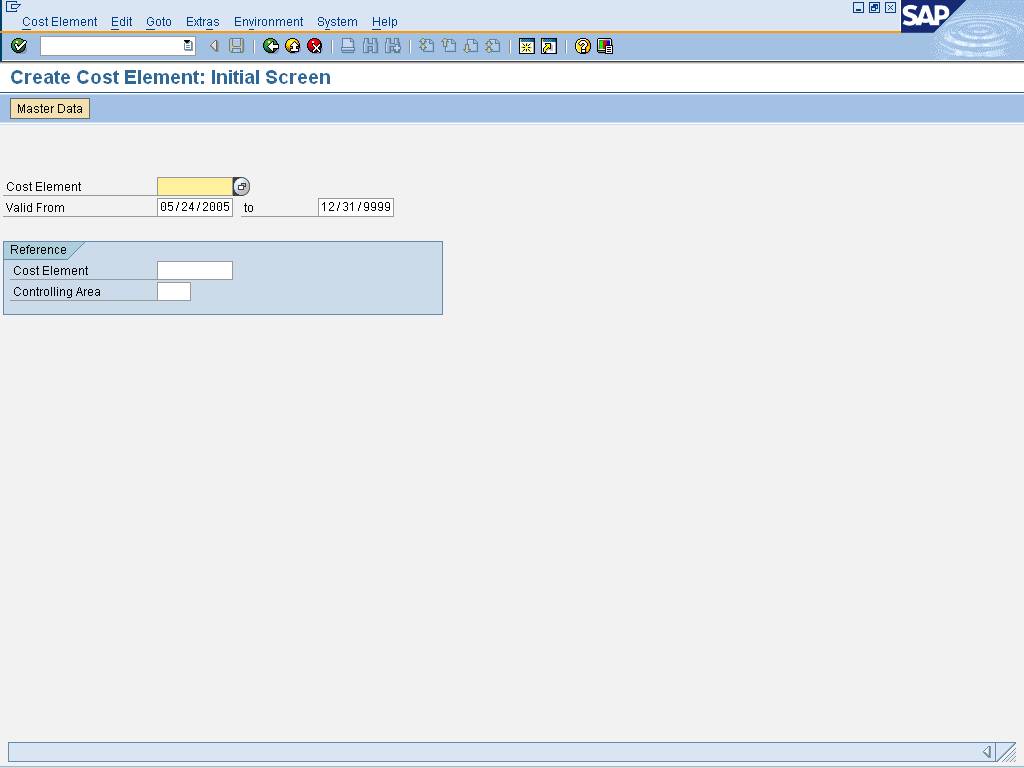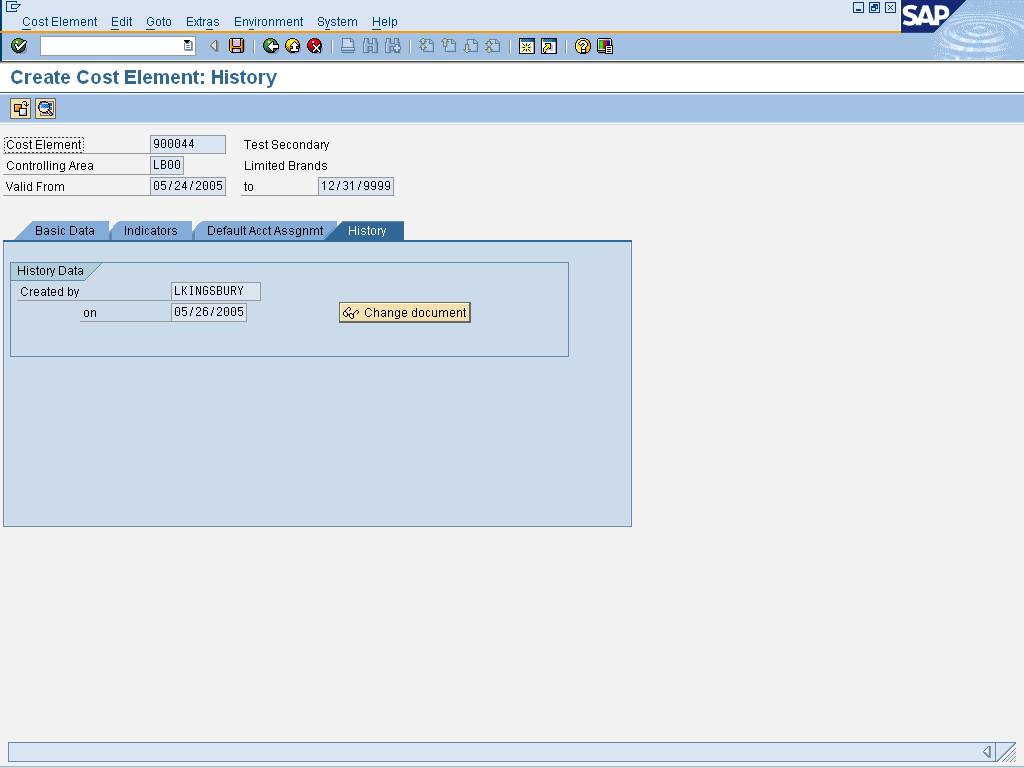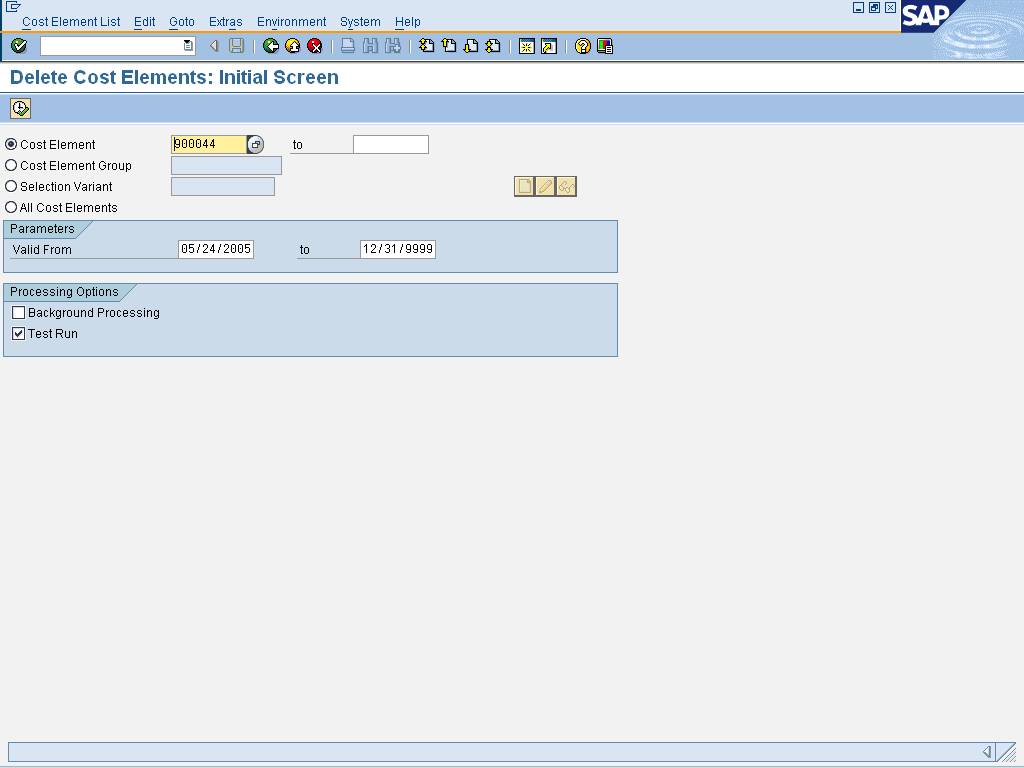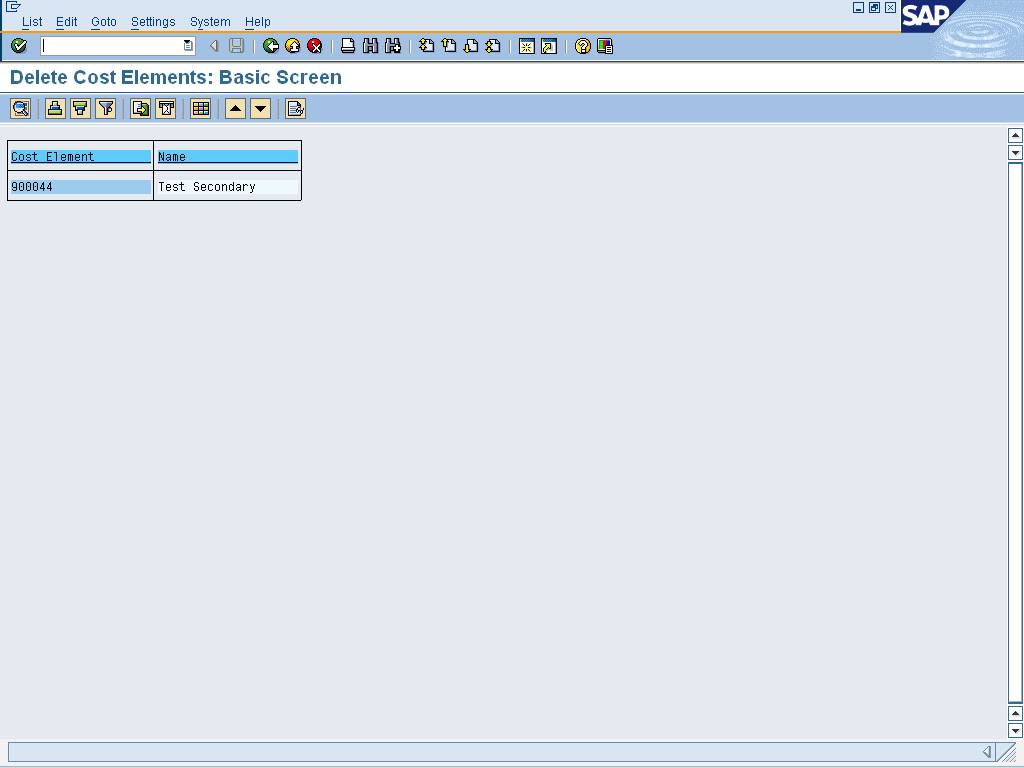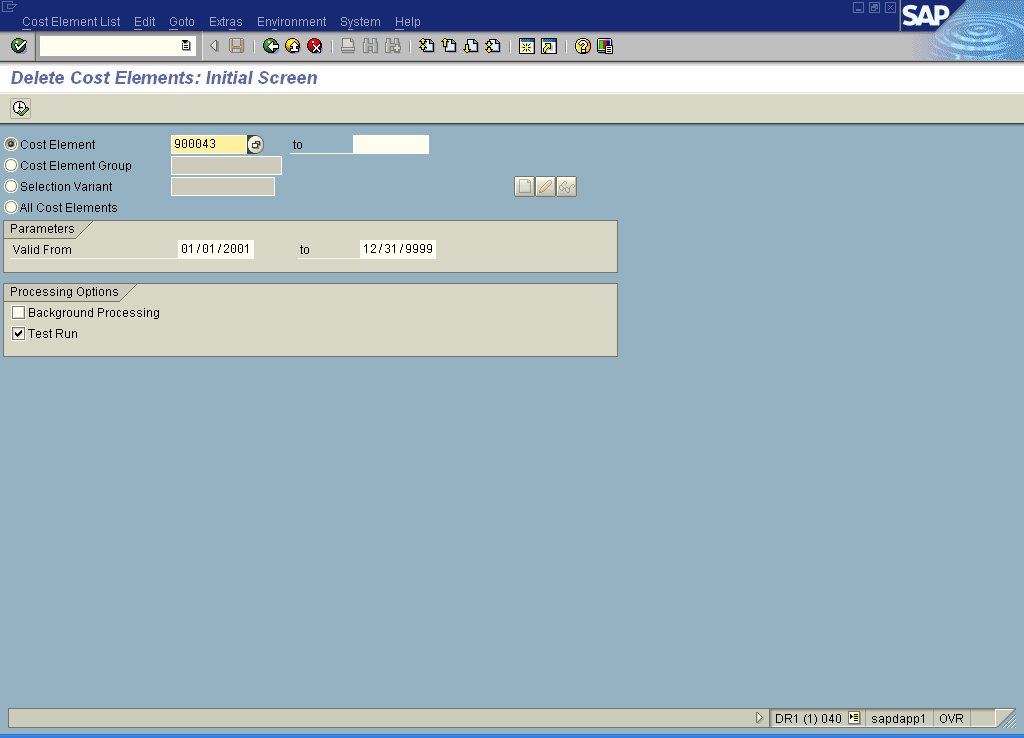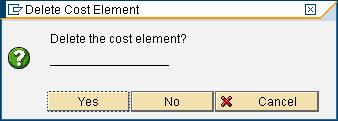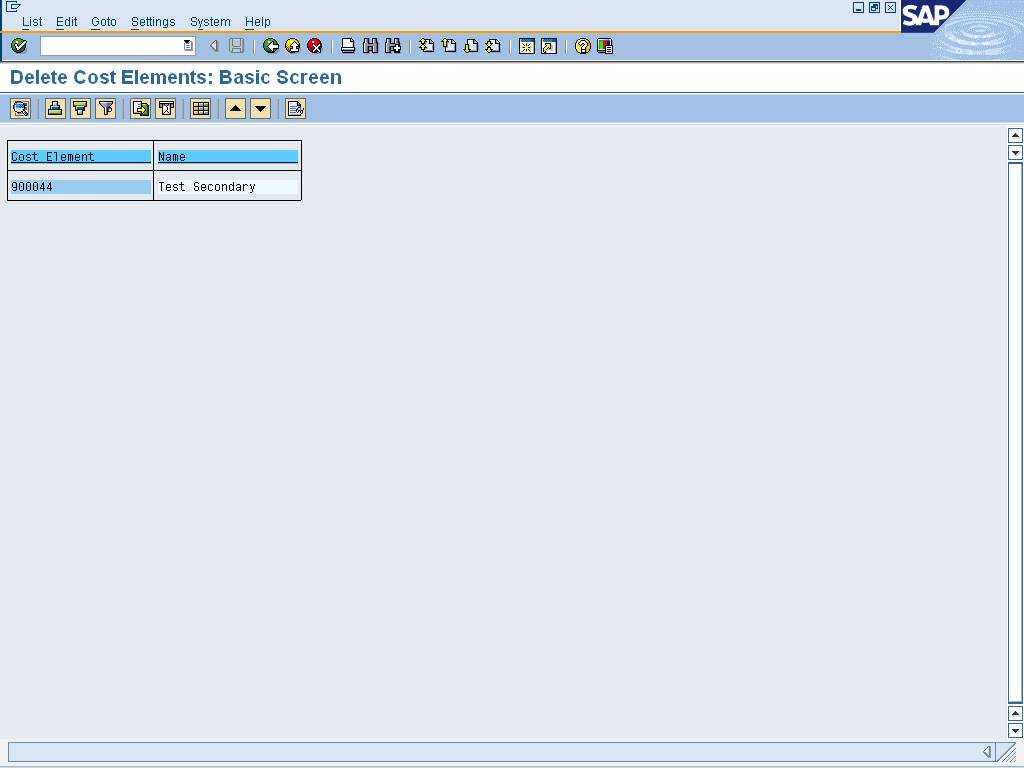Create a Secondary Cost Element- KA06 (KA06)
Purpose
Use this transaction to create secondary cost elements.
When To Do This
Perform this procedure when an approved request for
creating a secondary cost element is received in the Shared Service Center.
Prerequisites
None
Menu Path
Use the following menu path to begin this transaction:
·
Select to access the Create Cost Element: Initial Screen.
Transaction Code
Helpful Hints
·
Use the Create with Reference function if the cost elements with
similar attributes are already available.
Procedure
1. Perform one of the following:
|
If
|
Then
|
|
Creating a secondary cost element,
|
Go to Step 2
|
|
Collectively deleting cost elements,
|
Go to Step 12
|
|
Exiting the transaction,
|
Go to Step 29
|
2. Start
the transaction using the menu path or transaction code KA06.
 When accessing this transaction for the
first time in a session, the system prompts to Set
Controlling Area. The system does not prompt for the controlling area
again during the current session, indicating that controlling area LB00 has
already been set.
When accessing this transaction for the
first time in a session, the system prompts to Set
Controlling Area. The system does not prompt for the controlling area
again during the current session, indicating that controlling area LB00 has
already been set.
 Use the menu path
Use the menu path
Set
Controlling Area
3. As required, complete/review the following fields:
|
Field Name
|
R/O/C
|
Description
|
|
Controlling Area
|
R
|
Self-contained
organizational unit for cost accounting.
Example: LB00
|
 If the controlling is always the same,
click
If the controlling is always the same,
click  to make the entered
controlling area the default. The system will not prompt for the controlling
area in subsequent sessions.
to make the entered
controlling area the default. The system will not prompt for the controlling
area in subsequent sessions.
4. Click  .
.
Create
Cost Element: Initial Screen
5. As required, complete/review the following fields:
|
Field Name
|
R/O/C
|
Description
|
|
Cost Element
|
R
|
Primary cost elements
have a one-to-one relationship with general ledger expense accounts. Whenever
costs are posted, they must be assigned to a specific cost element.
Secondary cost elements, used to record internal allocations, have no
counterpart in the financial accounts and are maintained exclusively in cost
accounting.
 Use number range 910000 - 919999 for
assessments; use number range 930000 - 939999 for allocations; use number
range 950000 - 959999 for internal orders. Use number range 910000 - 919999 for
assessments; use number range 930000 - 939999 for allocations; use number
range 950000 - 959999 for internal orders.
Example: 900043
|
|
Valid From
|
R
|
Beginning date when
specifying a range of dates.
Example: 01/01/00
|
|
To
|
R
|
Upper limit of the range
to be selected from a list.
Example: 01/01/2006
|
6. Click  .
.
Create
Cost Element: Basic Screen
7. As required, complete/review the following fields:
|
Field Name
|
R/O/C
|
Description
|
|
Name
|
R
|
Person's, company's or
item's name.
Example: Assess-Out-DC
|
|
Description
|
R
|
Text to identify and
characterize an object or activity.
Example: Assessment
- Distribution act from LLS
|
|
Cost Element Category
|
R
|
An attribute that
determines the type of cost element.
Example: 42
|
 The following table explains when to select
which cost element category:
The following table explains when to select
which cost element category:
|
If
|
Then
|
|
The cost element is for internal settlements
|
Use Cost Element Category 21.
|
|
The cost element is for assessments
|
Use Cost Element Category 42
|
|
The cost element is for allocations,
|
Use Cost Element Category 43
|
8. Click the  tab.
tab.
 A cost center or an order can be set as a
default account assignment object. However, it is not advisable to default at
the cost element level.
A cost center or an order can be set as a
default account assignment object. However, it is not advisable to default at
the cost element level.
Create
Cost Element: Default Account Assignment
9. Click the  tab.
tab.
Create
Cost Element: History
10. Click  .
.
 The system displays the message "Cost
Element XXXX has been created."
The system displays the message "Cost
Element XXXX has been created."
11. Return
to Step 1
12. Start the transaction using the menu path or transaction code KA24.
Delete
Cost Elements: Initial Screen
13. As required, complete/review the following fields:
|
Field Name
|
R/O/C
|
Description
|
|
Cost Element
|
R
|
Primary cost elements
have a one-to-one relationship with general ledger expense accounts. Whenever
costs are posted, they must be assigned to a specific cost element.
Secondary cost elements, used to record internal allocations, have no
counterpart in the financial accounts and are maintained exclusively in cost
accounting.
Example: 900043
|
14. Select  to delete a range of
cost elements.
to delete a range of
cost elements.
15. Select  to delete a cost
element group.
to delete a cost
element group.
16. As required, complete/review the following fields:
|
Field Name
|
R/O/C
|
Description
|
|
Cost Element Group
|
R
|
Hierarchical grouping of
cost elements created to facilitate data entry and reporting.
Example: LTS-A
|
17. Select  to delete the cost
elements which are a part of a selection variant.
to delete the cost
elements which are a part of a selection variant.
 A selection variant allows for the storage of
a defined data set.
A selection variant allows for the storage of
a defined data set.
18. As required, complete/review the following fields:
|
Field Name
|
R/O/C
|
Description
|
|
Selection Variant
|
R
|
Saved selection criteria
used to generate reports. Instead of entering new criteria every time a
report is executed, sets of criteria can be stored. Reports can have
different variants associated with them, with each variant providing
different information.
Example: SEL-1
|
19. Select  to delete all the cost
elements.
to delete all the cost
elements.
20. As required, complete/review the following fields:
|
Field Name
|
R/O/C
|
Description
|
|
Valid From
|
R
|
Beginning date when
specifying a range of dates.
Example: 01/01/2001
|
|
to
|
R
|
Upper limit of the range
to be selected from a list.
Example: 12/31/9999
|
21. Select  to delete in the
background.
to delete in the
background.
22. Select  .
.
 It is advisable to perform the delete first
in a test run and determine if there are errors prior to performing the actual
delete.
It is advisable to perform the delete first
in a test run and determine if there are errors prior to performing the actual
delete.
23. Click  .
.
Delete
Cost Elements: Basic Screen
24. Click  to return to the Delete Cost Elements: Initial Screen.
to return to the Delete Cost Elements: Initial Screen.
Delete
Cost Elements: Initial Screen
25. Deselect  .
.
26. Click  .
.
Delete
Cost Element
27. Click  to delete the cost
element.
to delete the cost
element.
Delete
Cost Elements: Basic Screen
 It is not possible to delete the cost
elements if the transaction data posted to the cost element. However, they can
be deleted for future periods.
It is not possible to delete the cost
elements if the transaction data posted to the cost element. However, they can
be deleted for future periods.
28. Click  to return to the Delete Cost Elements: Initial Screen.
to return to the Delete Cost Elements: Initial Screen.
29. You have completed the transaction.
Result
You have successfully created a secondary cost element.
Also, you have successfully deleted all the cost elements.
Comments
None
![]() Controlling
Controlling ![]() Cost Element Accounting
Cost Element Accounting ![]() Master Data
Master Data ![]() Individual processing
Individual processing ![]() Create secondary to access the Create Cost Element: Initial Screen.
Create secondary to access the Create Cost Element: Initial Screen.
